Historians and artifacts corroborating the bible
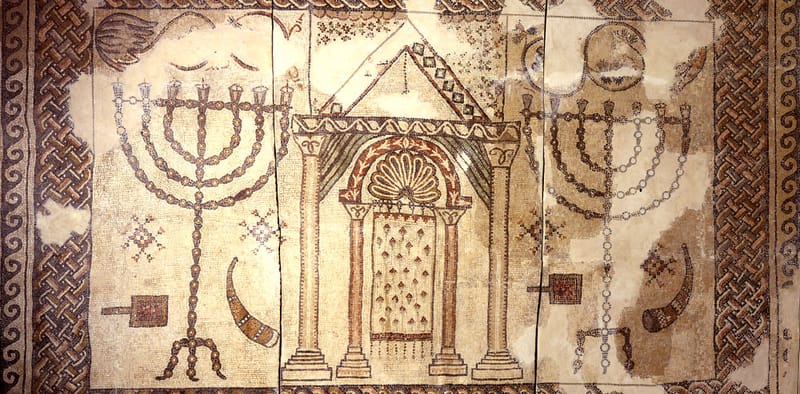
Here are a list of Historians who prove that the Messiah walked the earth.
1. Mara Bar Serapion

Mara bar Serapion was a Stoic philosopher from the Roman province of Syria. He is noted for a letter he wrote in Aramaic to his son, who was named Serapion.[1][2] The letter was composed sometime after 73 AD but before the 3rd century, and most scholars date it to shortly after 73 AD during the first century.[3] The letter may be an early non-Christian reference to the crucifixion of Jesus.[1][4]
The letter refers to the unjust treatment of "three wise men": the murder of Socrates, the burning of Pythagoras, and the execution of "the wise king" of the Jews.[1][2] The author explains that in all three cases the wrongdoing resulted in the future punishment of those responsible by God and that when the wise are oppressed, not only does their wisdom triumph in the end, but God punishes their oppressors.[5]
The letter has been claimed to include no Christian themes[2][4] and many scholars consider Mara a pagan,[2][4][6][7] although some suggest he may have been a monotheist.[3] Some scholars see the reference to the execution of a "wise king" of the Jews as an early non-Christian reference to Jesus.[1][2][4] Criteria that support the non-Christian origin of the letter include the observation that "king of the Jews" was not a Christian title, and that the letter's premise that Jesus lives on in his teachings he enacted is in contrast to the Christian concept that Jesus continues to live through his resurrection.[4][5]
Scholars such as Robert Van Voorst see little doubt that the reference to the execution of the "king of the Jews" is about the death of Jesus.[5] Others such as Craig A. Evans see less value in the letter, given its uncertain date, and the ambiguity in the reference.[8]
More details can be found about Mara Bar Serapion here https://en.wikipedia.org/wiki/Mara_bar_Serapion_on_Jesus
https://www.kyleorton.com/p/a-possible-early-reference-to-jesus
2. Philo of Alexandria
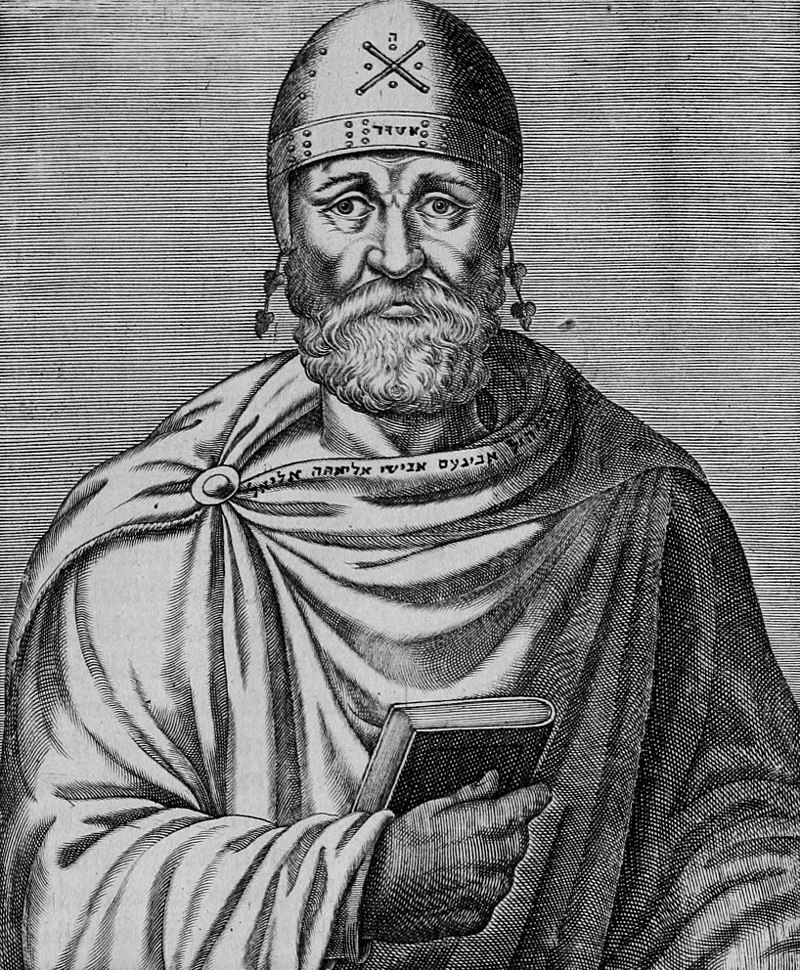
Philo of Alexandria ( Greek : Φίλων ὁ Ἀλεξανδρεύς , Philôn ho Alexandreus , Latin : Philo Judaeus , "Philo the Jew", Hebrew : פילון האלכסנדרוני ( Pylwn Hʾalksandrwny )) 1 is a Hellenized Jewish philosopher who was born in Alexandria around 20 BC and died in the same city around 45 AD. Contemporary of the early Christian era, he lived in Alexandria, which was then the great intellectual center of the Mediterranean. The city had a large Jewish community of which Philo was one of the representatives to the Roman authorities. His abundant work is mainly apologetic , intending to demonstrate the perfect adequacy between the Jewish faith and Hellenic philosophy .
In his work, Philo interprets the Bible through Greek philosophy mainly with the help of Plato and the Stoics . This will result in the centuries that follow not in a submission of theology to philosophy, but on the contrary of philosophy to the Scriptures . If Philo's thought permeates the Fathers of the Church , including Origen , Ambrose of Milan and Augustine of Hippo , his influence is weak on the Jewish tradition, in particular on the rabbinical tradition which will arise one or two centuries after his death. This is partly due to the fact that he uses the Septuagint (Bible translated into Greek) rather than a Bible in Hebrew, and partly to the fact that he interprets the Torah in an allegorical way . His work also gives indications on religious movements which have now disappeared such as the Therapeutae of Alexandria.
Philo was the first to think of God as the architect of the universe: similarly in Plato 's Timaeus the demiurge is a craftsman, while in Aristotle the world is uncreated. God being transcendent , his work gives great importance to divine Providence and grace , recognizing that the world belongs to God and not to men. Thus, if human beings can have a certain spiritual kinship with God, they are not on the same level as him. To believe the opposite would be to succumb to evil. God acts by means of divine powers: that which creates, that which orders, that which prohibits, compassion or mercy and finally royal or sovereign power. For Philo, there are two kinds of angels: those who helped God create the world and those who assist men in their ascension towards God.
In his Ethics , Philo distinguishes between bad passions (desire, fear, sadness and pleasure) and good passions (joy, caution and will). He compares the four virtues of prudence (or self-control), temperance, courage and justice to the four rivers of paradise. Virtuous beings are a benefit to those around them and find their own reward in just and virtuous action. Human beings are not naturally virtuous, however, and need appropriate laws, derived from natural law , to live together as best they can. Therefore, while maintaining, following the Stoics, that men belong to a natural community, he believes that this must be divided into nations in order to be viable.
If for Philo democracy is the best form of government, he considers it to be always threatened, either by an excess of freedom or by the weakness of the leaders. He also insists on the fact that the latter must be wise and concerned with justice and equality. Finally, while recognizing the necessity of politics, he shows a certain distrust towards the political figures symbolized by the person of Joseph (son of Jacob) towards whom he has ambivalent feelings. Philo's work will be rediscovered in the 16th and 17th centuries and translated or quoted by eminent jurists, such as Guillaume Budé and Cardin Lebret , whose work will influence French thinking on the State and the notion of sovereignty developed during this period.
More details can be found about Philo here https://fr.wikipedia.org/wiki/Philon_d%27Alexandrie
3. Passing of Peregrinus

The Passing of Peregrinus or The Death of Peregrinus (Greek: Περὶ τῆς Περεγρίνου Τελευτῆς; Latin: De Morte Peregrini) is a satire by the Syrian Greek writer Lucian in which the lead character, the Cynic philosopher Peregrinus Proteus, takes advantage of the generosity of Christians and lives a disingenuous life before burning himself at the Olympic Games of 165 AD. The text is historically significant because it contains one of the earliest evaluations of early Christianity by a non-Christian author.[1]
Lucian, The Passing of Peregrinus
More details can be found about Lucian here https://en.wikipedia.org/wiki/Passing_of_Peregrinus#:~:text=The%20Passing%20of%20Peregrinus%20or,lives%20a%20disingenuous%20life%20before
4. Kurkh Monoliths

The Kurkh Monoliths are two Assyrian stelae of c. 852 BC & 879 BC that contain a description of the reigns of Ashurnasirpal II and his son Shalmaneser III. The Monoliths were discovered in 1861 by a British archaeologist John George Taylor, who was the British Consul-General stationed in the Ottoman Eyalet of Kurdistan, at a site called Kurkh, which is now known Üçtepe Höyük, in the district of Bismil, in the province of Diyarbakir of Turkey. Both stelae were donated by Taylor to the British Museum in 1863.[1]
The Shalmaneser III monolith contains a description of the Battle of Qarqar at the end. This description contains the name "A-ha-ab-bu Sir-ila-a-a" which is generally accepted to be a reference to Ahab, king of Israel;[2][3] although this is the only reference to the term "Israel" in Assyrian and Babylonian records, which usually refer to the Northern Kingdom as the "House of Omri" in reference to its ruling dynasty—a fact brought up by some scholars who dispute the proposed translation.[4][5] It is also one of four known contemporary inscriptions containing the name of Israel, the others being the Merneptah Stele, the Tel Dan Stele, and the Mesha Stele.[6][7][8] This description is also the oldest document that mentions the Arabs.[9]
According to the inscription Ahab committed a force of 2,000 chariots and 10,000 foot soldiers to the coalition against Assyria.[10
More details can be found about Kurkh Monoliths here https://en.wikipedia.org/wiki/Kurkh_Monoliths
5. Bubastite Portal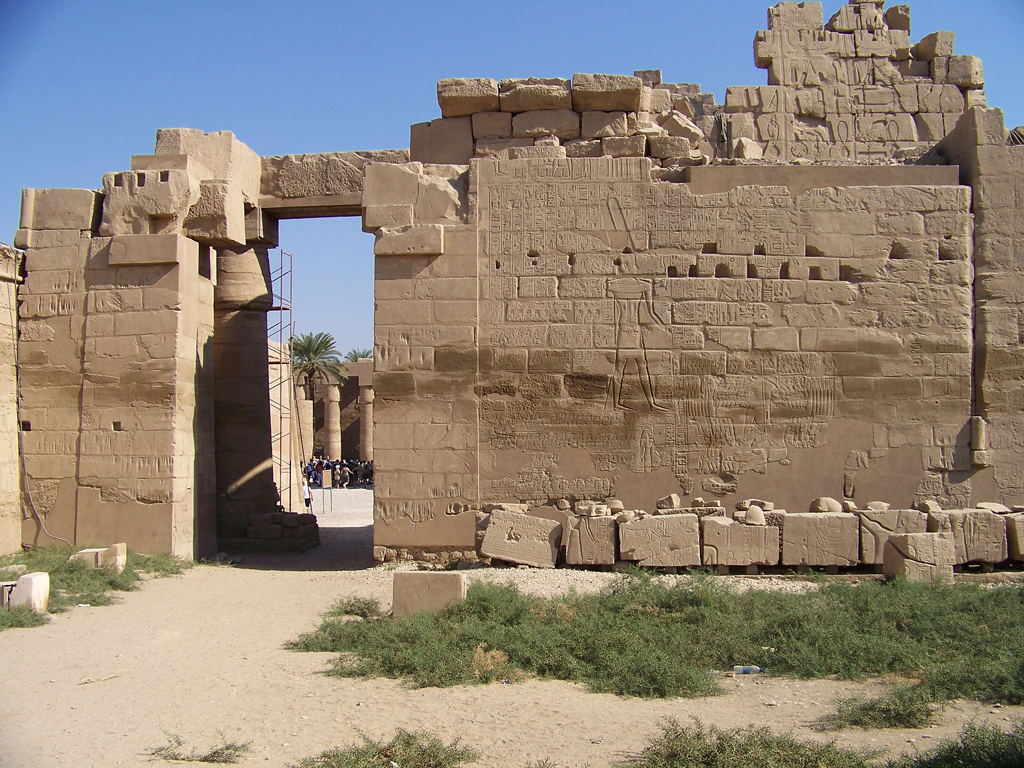
The Bubastite Portal gate is located in Karnak, within the Precinct of Amun-Re temple complex, between the temple of Ramesses III and the second pylon. It records the conquests and military campaigns c. 925 BC of Shoshenq I, of the Twenty-second Dynasty.[1] Shoshenq has been identified with the biblical Shishaq, such that the relief is also known as the Shishak Inscription or Shishaq Relief.[2]
History[edit]
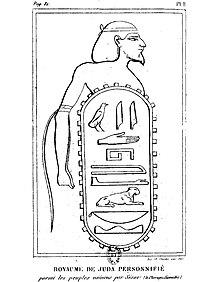
This gate was erected by the kings of the Twenty-second Dynasty of Egypt, also known as the "Bubastite Dynasty". It is located to the south-east side of the Temple of Ramesses III.
Although Karnak had been known to Europeans since the end of the Middle Ages, the possible significance of the Bubastite Portal was not apparent prior to the decipherment of hieroglyphs. Jean-François Champollion visited Karnak in 1828, six years after his publication of the Rosetta Stone translation. In his letters he wrote:
More details can be found about Bubastite Portal here https://en.wikipedia.org/wiki/Bubastite_Portal
6. Black Obelisk of Shalmaneser III
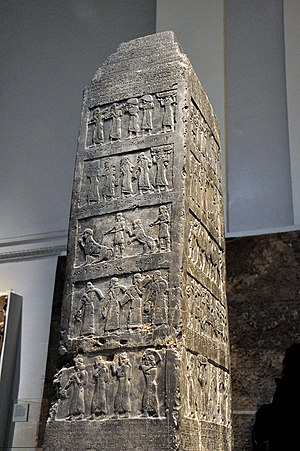
The Black Obelisk of Shalmaneser III is a black limestone Neo-Assyrian sculpture with many scenes in bas-relief and inscriptions. It comes from Nimrud (ancient Kalhu), in northern Iraq, and commemorates the deeds of King Shalmaneser III (reigned 858–824 BC). It is on display at the British Museum in London, and several other museums have cast replicas.
It is one of two complete Neo-Assyrian obelisks yet discovered, the other one being the much earlier White Obelisk of Ashurnasirpal I, and is historically significant because it is thought to display the earliest ancient depiction of a biblical figure – Jehu, King of Israel. The traditional identification of "Yaw" as Jehu has been questioned by some scholars, who proposed that the inscription refers to another king, Jehoram of Israel.[1][2] Its reference to Parsua is also the first known reference to the Persians.
Tribute offerings are shown being brought from identifiable regions and peoples. It was erected as a public monument in 825 BC at a time of civil war, in the central square of Nimrud. It was discovered by archaeologist Sir Austen Henry Layard in 1846 and is now in the British Museum.
More details can be found about Black Obelisk of Shalmaneser here https://en.wikipedia.org/wiki/Black_Obelisk_of_Shalmaneser_III#
7. Tel Dan Stele

The Tel Dan Stele is a fragmentary stele containing an Aramaic inscription which dates to the 9th century BCE. It is notable for possibly being the most significant and perhaps the only extra-biblical archaeological reference to the house of David.[1][2]
The Tel Dan Stele was discovered in 1993 in Tel-Dan by Gila Cook, a member of an archaeological team led by Avraham Biran. Its pieces were used to construct an ancient stone wall that survived into modern times.[2] The stele contains several lines of ancient Hebrew. The surviving inscription details that an individual killed Jehoram, King of Israel-Samaria, the son of Ahab, and Ahaziah of Judah, a king of the House of David.[1] The stele is currently on display at the Israel Museum,[3] and is known as KAI 310.
These writings corroborate passages from the Hebrew Bible, as the Second Book of Kings mentions that Jehoram is the son of an Israelite king, Ahab, by his Phoenician wife Jezebel. The likely candidate for having erected the stele, according to the Hebrew Bible, is Hazael, king of Aram-Damascus, whose language would have been Old Aramaic. He is mentioned in 2 Kings 12:17-18 as having conquered Israel-Samaria but not Jerusalem:
More details can be found about Tel Dan Stele here https://en.wikipedia.org/wiki/Tel_Dan_stele
See attached video, proof of some key biblical accounts


